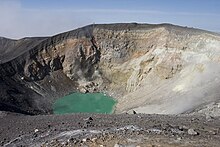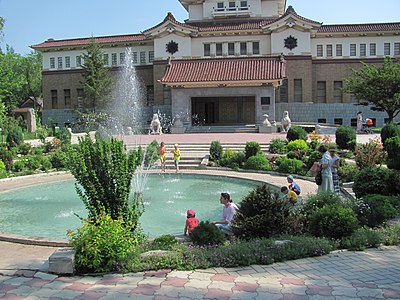Sakhalin Oblast
|
Subject of the Russian Federation
Sakhalin Oblast
Сахалинская область
|
||||||||||||||||||||||||||||||||||||
Coordinates: 49 ° 0 ' N , 149 ° 0' E
The Sakhalin Oblast ( Russian Сахалинская область / Sakhalinskaja oblast ) comprises the island of Sakhalin and the Kuril Islands, some of which are claimed by Japan . Sakhalin is an oblast in the Far East Federal District of Russia .
geography
The Tatar Sound separates Sakhalin from mainland Russia, the Kuril Islands form an island arc from Kamchatka to the Japanese island of Hokkaidō . On the west side of the Tatar Sound lies the Khabarovsk region , in the north - across the Sea of Okhotsk - the Kamchatka region . In the south lies Japan, more precisely the island of Hokkaido.
Sakhalin Island is very mountainous. The extension from north to south is 948 km. The Kuril Islands extend over a length of 1,200 km. There are numerous volcanoes.
climate
The climate is very harsh. Monthly highs of over 20 ° are reached in July and August. But from November to April they are between −7 ° and + 4 °. The monthly average temperatures at night from October to May are −18.4 ° to + 0.3 °. The climate is characterized by cold winters and humid summers. The weather is most pleasant in the south-east and the wildest in the north-west. The number of sunny days increases from north to south, the number of bad weather days decreases from west to east.
population
The last Russian censuses in 2002 and 2010 showed a population of 546,695 and 497,973 residents, respectively. The number of inhabitants thus fell by 48,722 people (−8.91%) in these eight years. In 2010 397,106 people lived in cities. This corresponds to 79.74% of the population (in Russia 73%). By January 1, 2014, the population decreased further to 491,027 people. The distribution of the different ethnic groups was as follows:
| nationality | VZ 1989 | percent | VZ 2002 | percent | VZ 2010 | percent |
|---|---|---|---|---|---|---|
| Russians | 579,887 | 81.65 | 460,778 | 84.28 | 409.786 | 82.29 |
| Korean | 35.191 | 4.95 | 29,592 | 5.41 | 24,993 | 5.02 |
| Ukrainians | 46.216 | 6.51 | 21,831 | 3.99 | 12,136 | 2.44 |
| Tatars | 10,699 | 1.51 | 6,830 | 1.25 | 4,880 | 0.98 |
| Belarusians | 11,423 | 1.61 | 5,455 | 1.00 | 2,994 | 0.60 |
| Niwchen | 2.008 | 0.28 | 2,450 | 0.45 | 2,290 | 0.46 |
| Kyrgyz | 241 | 0.03 | 86 | 0.02 | 1,763 | 0.35 |
| Mordwinen | 5,641 | 0.79 | 2,943 | 0.54 | 1,666 | 0.33 |
| Uzbeks | 763 | 0.11 | 298 | 0.05 | 1,518 | 0.30 |
| Armenians | 804 | 0.11 | 1,144 | 0.21 | 1,240 | 0.25 |
| Azerbaijanis | 951 | 0.13 | 1,138 | 0.21 | 1,155 | 0.23 |
| Tschuwaschen | 2,452 | 0.35 | 1,300 | 0.24 | 822 | 0.17 |
| Moldovans | 1,456 | 0.21 | 751 | 0.14 | 581 | 0.12 |
| Bashkirs | 1,019 | 0.14 | 586 | 0.11 | 527 | 0.11 |
| German | 1,230 | 0.17 | 902 | 0.16 | 493 | 0.10 |
| Kazakhs | 1,069 | 0.15 | 554 | 0.10 | 428 | 0.09 |
| Residents | 710.242 | 100.00 | 546,695 | 100.00 | 497.973 | 100.00 |
Note: the proportions refer to the total number of inhabitants. Including the group of people who did not provide any information about their ethnic affiliation (2002 3,387 and 2010 24,035 people)
The area's population is roughly 85% Russian. The Koreans (highest proportion in all of Russia) and Ukrainians are the most important ethnic minorities in Sakhalin Oblast. The number of Koreans - like the number of many other ethnic groups - is falling sharply, however. In contrast, the number of Niwchen, Kyrgyz, Uzbeks, Armenians and Azerbaijanis is increasing. Several thousand people have immigrated from the North Caucasus, Transcaucasus and Central Asia since the end of the Soviet Union, albeit in far fewer numbers than in other regions of Russia.
native people
The natives of Sakhalin are the Niwchen , Nanai , Oroken (also called Ulta, Ulten or Uilta), Ultschen , Orotschen and Evenks . They are traditionally fishermen and reindeer herders . The Ainu who lived here until 1945 were deported to Japan. It is not known whether Ainus will be among the 219 Japanese in 2010. The locals now make up only a fraction of the population of Sakhalin Oblast and some of them are heavily Russified. Here is an overview:
| nationality | VZ 1989 | percent | VZ 2002 | percent | VZ 2010 | percent |
|---|---|---|---|---|---|---|
| Niwchen | 2.008 | 0.28 | 2,450 | 0.45 | 2,290 | 0.46 |
| Nanaians | 173 | 0.02 | 159 | 0.03 | 148 | 0.03 |
| Oroken (Ultschen) | 129 | 0.02 | 298 | 0.05 | 259 | 0.05 |
| Oroch | 212 | 0.03 | 42 | 0.01 | 28 | 0.01 |
| Evenks | 188 | 0.03 | 243 | 0.04 | 209 | 0.04 |
| Itelmenen | 3 | 0.00 | 8th | 0.00 | 15th | 0.00 |
| Ewenen | 50 | 0.01 | 8th | 0.00 | 15th | 0.00 |
| Residents | 710.242 | 100.00 | 546,695 | 100.00 | 497.973 | 100.00 |
history
The islands, which were annexed by Russia in the 19th century, were long disputed between Russia and Japan. At the end of the 19th century there were a number of labor camps on Sakhalin. It was not until 1945 that the Soviet Union conquered South Sakhalin ( Karafuto ) and the Kuril Islands from Japan and in 1947 formed the oblast in its present form, which has been limited to the northern part of Sakhalin since 1932 as part of the Far Eastern Region ( Krai ) or the Khabarovsk region .
economy
The capital and only major city of the Oblast is Yuzhno-Sakhalinsk .
Crude oil and natural gas are mainly produced in northern Sakhalin:
- Sakhalin-1 estimated at 307 million tons of oil and 485 billion m³ of natural gas
- Sakhalin-2 estimated at 140 million tons of oil and 550 billion m³ of natural gas
- Sakhalin-3 uncertain 700 million tons of oil, 1.3 trillion m³ of natural gas
- Sakhalin-4 estimated at 123 million tons of oil and 540 billion m³ of natural gas
- Sakhalin-5 estimated at 600 million tons of oil and 600 billion m³ of natural gas
However, their exploitation causes considerable environmental problems.
Other important industries are fishing and the timber industry.
politics
From August 2007 to March 2015, the governor of the oblast was the former mayor of the city of Okha Alexander Khoroshavin, who replaced the resigned Ivan Malachov. After Khoroshavin was arrested in March 2015 and investigations into corruption were initiated, he was replaced by the previous governor of Amur Oblast, Oleg Koschemjako .
Administrative divisions and cities
Sakhalin Oblast is divided into 17 Rajons and one urban district. The only major city in Sakhalin Oblast is its administrative center of Yuzhno-Sakhalinsk , which also forms the only urban district. There are a total of 14 cities and 6 urban-type settlements in the oblast .
| Surname | Russian | Residents (October 14, 2010) |
|---|---|---|
| Yuzhno-Sakhalinsk | Южно-Сахалинск | 181,728 |
| Korsakov | Корсаков | 33,526 |
| Cholmsk | Холмск | 30,937 |
| Oh yeah | Оха | 23.008 |
| Poronaisk | Поронайск | 16,120 |
traffic
The oblast can be reached by ship from mainland Russia. There has also been a ferry connection to Japan since 1999. Sakhalin also maintains flight connections to Russia, Japan, South Korea and China. Since the Tatarensund between Sakhalin and the mainland is only seven kilometers wide at its narrowest point, there are plans for a fixed connection through a tunnel or bridge. So far, however, no start of construction is known.
There are three different modes of transportation on Sakhalin Island: by bus (regular bus service) or by car, by ship or by train. The Sakhalin Children's Railway runs on a 2 km long narrow-gauge line in Yuzhno-Sakhalinsk .
Web links
- Official website of Sakhalin Oblast (Russian)
References and comments
- ↑ Administrativno-territorialʹnoe delenie po subʺektam Rossijskoj Federacii na 1 janvarja 2010 goda (administrative-territorial division according to subjects of the Russian Federation as of January 1, 2010). ( Download from the website of the Federal Service for State Statistics of the Russian Federation)
- ↑ a b Itogi Vserossijskoj perepisi naselenija 2010 goda. Tom 1. Čislennostʹ i razmeščenie naselenija (Results of the All-Russian Census 2010. Volume 1. Number and distribution of the population). Tables 5 , pp. 12-209; 11 , pp. 312–979 (download from the website of the Federal Service for State Statistics of the Russian Federation)
- ↑ Oil deposits in Russia (January 25, 2006) ( Memento of the original of September 28, 2007 in the Internet Archive ) Info: The archive link was automatically inserted and not yet checked. Please check the original and archive link according to the instructions and then remove this notice.
- ↑ Oil and gas abundance endangers indigenous people and unique nature
- ↑ Report on the city portal Ocha (Russian)








